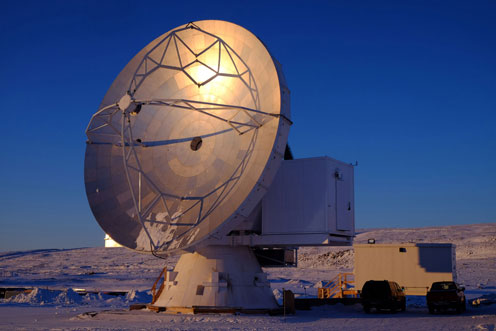Greenland Telescope to image black holes by moving onto the Greenland ice sheet
Scientists from the Niels Bohr Institute, University of Copenhagen, will soon be able to participate in the “Event Horizon Telescope” (EHT) with the Greenland Telescope (GLT). The GLT will become part of a global network of radio telescopes designed to get the first images of black holes.

How do you take a picture of something that emits no light?
It’s hard to get an image of a black hole. They are the darkest objects in the universe because their gravity is so intense that no light can escape them, and their tremendous density makes them very small in spite of their enormous mass.
To overcome these problems, the experiment is targeting much larger black holes than normal, namely so-called supermassive black holes, millions or billions of times more massive than the sun, as well as distributing the network of telescopes across the Globe to maximise the resolution of the image.
It is possible to detect the black hole because the EHT can image the “shadow” of the black hole against a bright background of hot material near it.
While black holes have been theoretically expected for the best part of a century, the first conclusive evidence for the existence of black holes was only obtained in 2015, when gravitational waves from a merger of two (smaller) black holes were detected.
However, so far, no one has ever managed to get an image of a black hole because they are so small and so dark. In the center of almost every galaxy in the Universe there is a compact and supermassive object that astronomers believe to be supermassive black holes, vastly more massive than the merging black holes detected in 2015.
But the final evidence is still lacking that these concentrations of mass in the hearts of galaxies are actually black holes. By detecting and creating an image of the black hole, viewed in contrast against the powerful radiation from the gas being drawn into the hole, researchers can confirm that the compact object doesn’t have a surface to reflect any light, and that light behaves in the warped way that we expect from the theory of general relativity near a black hole and its strong gravitational field.
Danish access to the data EHT will be producing
A press conference was held at DTU Space on Wednesday 10. April, where the first results from the EHT consortium were presented. With the addition of the Greenland Telescope, the precision and sensitivity of the images will substantially increase, and at the same time, Danish researchers will gain access to the EHT.
“ It is fascinating to know that our generation is not only the first to learn, via detections of gravitational waves, that black holes really exist. We will also be the first to see what they look like!” says Marianne Vestergaard, associate professor at DARK, the Niels Bohr Institute and she continues:
“We, the researchers, are thrilled. These excellent results from the Event Horizon Telescope show us the remarkable things that a dedicated, global collaboration can achieve, and it reveals the great potential there is for exploring the complex parts of our universe of which black holes are a manifest. It is particularly enjoyable that we, the Danish researchers, will be able to contribute to this new type of telescope on the front line.
The Summit of the icecap will be the new home for the Greenland Telescope
Greenland Telescope will be moved to the Summit of the ice sheet, reaching an altitude of approx. 3000 meters above sea level. The air is much drier, and the clear, dry and cold climate will offer better observing conditions compared to the humid air along the coast. The complicated task of moving the telescope across the ice is planned to take place during the summer of 2021. Researchers from the Niels Bohr Institute’s Physics of Ice, Climate and Earth section are assisting in that operation.
Topics
See also:
Contact
Marianne Vestergaard, Associate Professor, DARK, Niels Bohr Institute, University of Copenhagen, Email: mvester@nbi.ku.dk - Phone: +45 35 32 59 09
